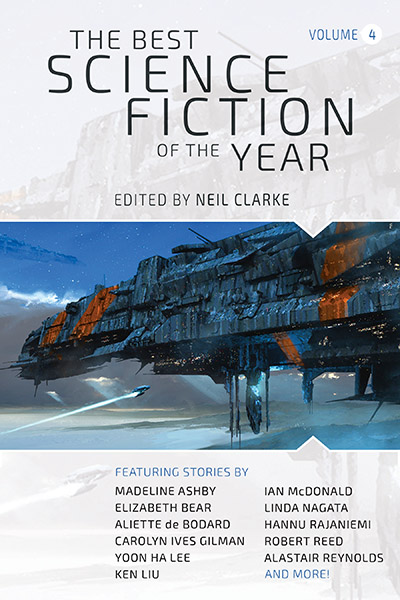
Neil Clarke has unveiled the table of contents for his The Best Science Fiction of the Year – Volume 4, which features science fiction short stories/novelettes/novellas originally published in 2018. The cover art is Mack Sztaba’s “Behemoth.”
Table of Contents
- “When We Were Starless” by Simone Heller (Clarkesworld Magazine, October 2018)
- “Intervention” by Kelly Robson (Infinity’s End, edited by Jonathan Strahan)
- “All the Time We’ve Left to Spend” by Alyssa Wong (Robots vs. Fairies, edited by Dominik Parisien and Navah Wolfe)
- “Domestic Violence” by Madeline Ashby (Slate, March 26, 2018)
- “Ten Landscapes of Nili Fossae” by Ian McDonald (2001: An Odyssey in Words, edited by Ian Whates and Tom Hunter)
- “Prophet of the Roads” by Naomi Kritzer (Infinity’s End, edited by Jonathan Strahan)
- “Traces of Us” by Vanessa Fogg (GigaNotoSaurus, March 2018)
- “Theories of Flight” by Linda Nagata (Asimov’s Science Fiction, November/December 2018)
- “Lab B-15” by Nick Wolven (Analog Science Fiction and Fact, March/April 2018)
- “Requiem” by Vandana Singh (Ambiguity Machines and Other Stories, Small Beer Press)
- “Sour Milk Girls” by Erin Roberts (Clarkesworld Magazine, January 2018)
- “Mother Tongues” by S. Qiouyi Lu (Asimov’s Science Fiction, January/February 2018)
- “Singles’ Day” by Samantha Murray (Interzone, September/October 2018)
- “Nine Last Days on Planet Earth” by Daryl Gregory (Tor.com, September 19, 2018)
- “The Buried Giant” by Lavie Tidhar (Robots vs. Fairies, edited by Dominik Parisien and Navah Wolfe)
- “The Anchorite Wakes” by R.S.A. Garcia (Clarkesworld Magazine, August 2018)
- “Entropy War” by Yoon Ha Lee (2001: An Odyssey in Words, edited by Ian Whates and Tom Hunter)
- “An Equation of State” by Robert Reed (The Magazine of Fantasy & Science Fiction, January/February 2018)
- “Quantifying Trust” by John Chu (Mother of Invention, edited by Rivqa Rafael and Tansy Rayner Roberts)
- “Hard Mary” by Sofia Samatar (Lightspeed Magazine, September 2018)
- “Freezing Rain, a Chance of Falling” by L.X. Beckett (The Magazine of Fantasy & Science Fiction, July/August 2018)
- “Okay, Glory” by Elizabeth Bear (Twelve Tomorrows, edited by Wade Roush)
- “Heavy Lifting” by A.T. Greenblatt (Uncanny Magazine, September/October 2018)
- “Lions and Gazelles” by Hannu Rajaniemi (Slate, September 27, 2018)
- “Different Seas” by Alastair Reynolds (Twelve Tomorrows, edited by Wade Roush)
- “Among the Water Buffaloes, a Tiger’s Steps” by Aliette de Bodard (Mechanical Animals, edited by Selena Chambers and Jason Heller)
- “Byzantine Empathy” by Ken Liu (Twelve Tomorrows, edited by Wade Roush)
- “Meat and Salt and Sparks” by Rich Larson (Tor.com, June 6, 2018)
- “Umbernight” by Carolyn Ives Gilman (Clarkesworld Magazine, February 2018)
The book’s release date is July 2.
[Thanks to Jason for the story.]
Discover more from File 770
Subscribe to get the latest posts to your email.

I’m really pleased to see Umbernight and “The Anchorite Awakes” on this list. I see the names of quite a few authors I’ve enjoyed, and I’m going to have to try those stories.
I only got 1/3 of the way through Freezing Rain; I found it tedious, with its annoying main character and his obsession with social “reputation”. Given the acclaim it’s gotten, I should probably give it another try, but I’m having a hard time mustering the enthusiasm.
Of the ones I’ve read, my favorites were “Umbernight”, “When We Were Starless”, and “Mother Tongues”.
Mine are “Umbernight,” “Nine Last Days,” and “Sour Milk Girls.” Looks like “Umbernight” has some traction. 🙂
As far as “Freezing Rain,” this was my take:
Basically, if the style was the problem for you, I’d say you might give it another try but since it was the character/social cred (I didn’t like him, either), I don’t think it’d get any better for you, though it does get more intense.
(But, like you say, people in the know seem to regard it more highly than I do.)